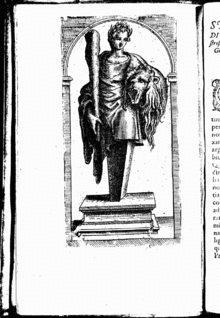Karl Friedrich von Jülich-Kleve-Berg
Karl Friedrich von Jülich-Kleve-Berg (born April 28, 1555 in Kleve , † February 9, 1575 in Rome ) was Hereditary Prince of the Duchies of Jülich, Kleve and Berg and the Counties of Mark and Ravensberg .
Life
Karl Friedrich was the eldest son of Duke Wilhelm the Rich and Maria von Habsburg , a daughter of Emperor Ferdinand I. He died prematurely, which happened to the 19-year-old on a pilgrimage and gentlemanly trip in Rome due to a fatal disease of the leaves , unintentionally left deep traces in the history of the Rhineland . Since there was no equivalent candidate for the throne in his place with his brother Johann Wilhelm , the gloomy end of the Jülich-Kleve-Berg house was inevitable with his death. If Karl Friedrich had stayed alive, there would have been no Jülich-Klevian succession dispute, Prussia would not have gained a foothold on the Rhine and today's map of Europe might look different.
Karl Friedrich, for whom his tutor Stephanus Winandus Pighius set a famous literary monument with Hercules Prodicius , whose text became the first travel guide for Italy, was a vital, highly intelligent and cheerful young man. At the opening ceremony of the Holy Year 1575 in St. Peter's Basilica at Christmas 1574 he was one of the guests of honor of Pope Gregory XIII. He was very interested in his guest, because he hoped that the young Hereditary Prince would later influence his countries, which were divided on the question of faith, as well as the neighboring Protestant areas in the spirit of the Counter-Reformation sought by the Holy See . Therefore, a week later, he awarded him the consecrated sword and hat , an honor as a Fidei defensor that was otherwise only given to kings. When Karl Friedrich died just five weeks later, Gregor XIII paid. the princely burial and the enormous funeral procession from its own coffers and left it in the Roman church of the German nation, Santa Maria dell'Anima , across from Pope Hadrian VI. to bury. He received a splendid honorary grave based on the design of his tutor Pighius, executed by the sculptors Nicolas Mostaert and Gillis van den Vliete, which shows, among other things, a resurrection scene that refers to an intensive examination of the Laocoon group found in 1506 . The second part of the tomb, a relief with the scene of the awarding of the consecrated sword by Gregory XIII, hangs today in the anteroom of the church. The inscription there says that the prince had a precocious mind, was of shining piety and understood many things and languages.
Individual evidence
- ↑ For example, on October 17, 1521, Pope Leo X had already awarded the title of Fidei defensor to the English King Henry VIII , who was to marry Karl Friedrich's aunt Anna almost 19 years later .
- ^ Photo of the relief in the Photo Archive Photo Marburg , accessed on the portal bildindex.de on April 5, 2013
literature
- Wilhelm Diedenhofen: The grave of the Klevian prince in Rome . In: Calendar for the Klever Land to the year 1967
- Wilhelm Diedenhofen: Death in Rome . In: Land at the Center of Powers. The duchies of Jülich, Kleve and Berg . Boss Verlag, Kleve 1985, ISBN 3-922384-46-3
- Wilhelm Diedenhofen: The trip to Italy of Prince Karl Friedrich von Jülich-Kleve-Berg 1574/75 . Kleve 2008, ISBN 978-3-935861-22-9
| personal data | |
|---|---|
| SURNAME | Karl Friedrich von Jülich-Kleve-Berg |
| BRIEF DESCRIPTION | Heir to the throne of Jülich-Kleve-Berg |
| DATE OF BIRTH | April 28, 1555 |
| PLACE OF BIRTH | Kleve |
| DATE OF DEATH | February 9, 1575 |
| Place of death | Rome |

